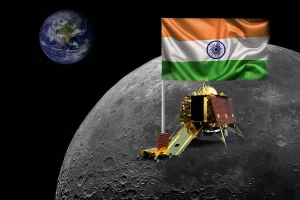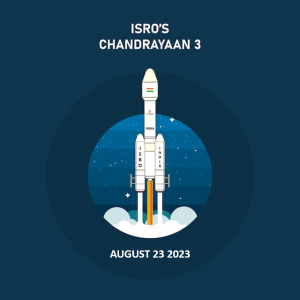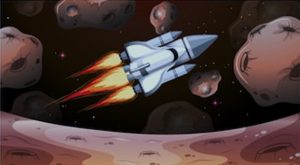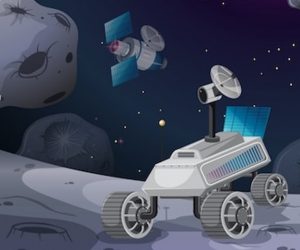In the mesmerizing expanse of space exploration, every mission is a cosmic gamble, each a dice roll against the unknown. India’s national space agency, the Indian Space Research Organization (ISRO), is poised to test its mettle yet again with the Chandrayaan-3 mission. After years of meticulous planning and arduous preparation, a moment of truth has arrived. The bold venture has successfully landed on the lunar surface, adding another chapter to India’s space odyssey. This article discusses the role of artificial intelligence (AI) behind Chandrayaan-3’s safe landing.
Also Read: IBM and NASA Join Forces to Create Earth Science GPT: Decoding Our Planet’s Mysteries

Artificial Intelligence: The Silent Navigator of Chandrayaan-3
A celestial symphony of technology and intellect is at play among the stars. What sets Chandrayaan-3 apart from its predecessors is its intricate integration with artificial intelligence (AI). As the spacecraft ventures into the lunar descent, AI takes center stage, conducting a complex symphony of sensors, cameras, and algorithms.
Also Read: zPod, India’s First AI-Driven Autonomous Vehicle
Behind the Scenes: The Players and Their Roles
Behind the scenes, ISRO’s Telemetry, Tracking, and Command Network (ISTRAC) hums with controlled excitement. Led by the mission director P. Veeramuthuvel and his dedicated team of scientists, this nerve center was ready for the ultimate lunar ballet. However, their involvement was limited during the nail-biting 15-minute descent phase, thanks to AI. The spacecraft relied on pre-programmed computer logic baked into its core for this high-stakes act.
Critical Descent: A Great Leap in Space for India
As the clock ticked to 17:47 hours on August 23, we all saw the story unfold. Mission control transitioned from active intervention to vigilant observation. Supercharged by AI, autonomous systems took charge of the spacecraft’s fate. The AI-driven sensors worked in unison, their task crystal clear – ensuring a safe landing. The success of Chandrayaan-3 hinged on this synchronized ballet of AI and technology.

Chandrayaan-3’s Sensors and AI’s Guiding Instruments
ISRO Chairman S. Somnath unveiled the ensemble of sensors guiding this cosmic venture. Velocimeters and altimeters contribute vital speed and altitude data, forming the backbone of AI’s navigation prowess. The array of cameras, from hazard avoidance to inertia-based, paints a visual canvas of the lunar terrain. These diverse inputs merge seamlessly through complex algorithms, crafting a holistic image of the lander’s whereabouts.
Also Read: AI Goes to Space! NASA to Roll Out ChatGPT-like Chatbot for Spacecraft Communication
At the heart of Chandrayaan-3’s success lies an intelligent navigation, guidance, and control system. This intricate web of algorithms orchestrates the spacecraft’s movements, directing its trajectory to ensure a secure touchdown. Every scenario is accounted for in AI’s meticulous planning – altitude adjustments, firing thrusters, and surface scanning for obstacles are all choreographed by the mind of AI.
Also Read: Alien-Inspired Spacecraft Design: NASA’s Bold Leap Into Space’s Future

Adaptive Intelligence: The Hero of Chandrayaan-3’s Descent
AI’s true prowess shined as it adapted and responded on the fly. Rigorous simulations, revamped guidance designs, and painstaking algorithms guaranteed precision during each descent phase. Even in the face of adversity, the craft held its course. Remarkably, Somnath unveils that even sensor failures didn’t deter the craft, thanks to its backup propulsion system.
The Lander Hazard Detection and Avoidance Camera (LHDAC) took center stage. Empowered by AI, it scanned the lunar landing zone’s contours, hunting for obstacles that could mar the touchdown. A symphony of sensors and cameras, all operated by AI, further ensured the lander’s safe passage.
Decoding the Descent: A Ballet of Sensors
The spacecraft’s journey from lunar heights to the gentle embrace of the surface was an intricate ballet spanning 15 minutes. Onboard sensors were the dancers, ceaselessly recalculating the trajectory. Critical junctures acted as checkpoints for sensor accuracy, with the grand finale being the hazard verification at just 150 meters above the surface.
Moon’s Servant: Pragyan, the AI-Powered Rover
The mission’s AI-driven grandeur doesn’t end with the lander. Pragyan, the lunar rover, continues the legacy. AI’s hand guides Pragyan’s navigation as it embarks on a day-long adventure, conducting experiments and collecting samples. Cameras and antennas, backed by AI, ensure Pragyan’s success in its lunar escapade.
Also Read: Introduction to Autonomous Navigation – LIDAR, Sensor Fusion, Kalman Filter

The Lunar Dilemma: Vertical or Lateral?
At the pinnacle of the mission’s AI-powered decision-making lies a pivotal choice. To avoid obstacles, the lander’s AI must decide between a vertical landing or a lateral move of up to 150 meters. As the world watches with bated breath, AI holds the fate of Chandrayaan-3 in its binary hands.
Our Say
ISRO’s epic space venture, powered by the prowess of AI, has landed safely on the moon. In the endless abyss of space, Chandrayaan-3’s touchdown is a triumphant manifestation of AI’s might and human ingenuity. As AI and sensors create a symphony of precision and adaptability, the moon’s surface becomes a canvas for India’s technological artistry.
Related
- SEO Powered Content & PR Distribution. Get Amplified Today.
- PlatoData.Network Vertical Generative Ai. Empower Yourself. Access Here.
- PlatoAiStream. Web3 Intelligence. Knowledge Amplified. Access Here.
- PlatoESG. Automotive / EVs, Carbon, CleanTech, Energy, Environment, Solar, Waste Management. Access Here.
- PlatoHealth. Biotech and Clinical Trials Intelligence. Access Here.
- ChartPrime. Elevate your Trading Game with ChartPrime. Access Here.
- BlockOffsets. Modernizing Environmental Offset Ownership. Access Here.
- Source: https://www.analyticsvidhya.com/blog/2023/08/chandrayaan-3-touchdown-how-ai-and-sensors-aided-isro-epic-lunar-venture/



